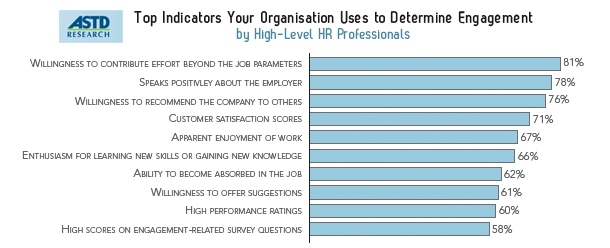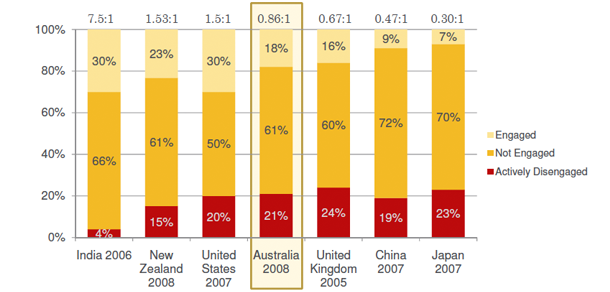Employee Engagement Research Summary
Employee engagement is the degree of emotional commitment that an employee has to his or her job and the organisation as a whole.
Engaged employees "go the extra mile” for their company, their colleagues and their customers, while disengaged employees do the bare minimum.
In 2007, the American Society for Training and Development conducted a survey of 776 HR professionals, primarily made up of HR Managers and HR Directors, asking them to consider the key indicators their organisation uses to determine what makes an employee engaged, ensuring each reason was to a high or very high extent, which produced the following results:
Origin of Employee Engagement
The first use of the term “employee engagement” was in a 1990 Academy of Management Journal by Yale organisational psychologist William A. Kahn called “Psychological Conditions of Personal Engagement and Disengagement at Work,” in which a person "drives personal energies into role behaviours."
It was only at the beginning of the 2000s that we began to hear the term "employee engagement" entering the mainstream business vocabulary, used as a fresh way of looking at established terms like job satisfaction and motivation. Engagement went further than simply being happy or enthusiastic about one's job, to being passionate, giving one's best effort on a daily basis, displaying intense loyalty and patriotism for the company, and intending to stay. Engagement was largely popularised as a result of survey vendors and management consultancies, in particular Gallup — the consultancy that is widely agreed to have popularised the term — as part of the most in-depth analysis on engagement ever conducted, known as the Gallup Q12.
Central Idea
Engagement is not just about having "casual T-shirt Fridays," or a quarterly offsite team building initiative, or bringing in a motivational speaker once a year. It is primarily an outcome of good leadership, culture, and management practices, which are the things most responsible for shaping employees' day-to-day experiences.
Discretionary Effort (DE)
The most common phrase you’ll hear when you start looking for definitions of engagement is “discretionary effort.” (Extra effort beyond what is expected.)
It has been suggested that there are 2 types of DE:
- “In-role DE” – extra effort given within their role (e.g., working after hours).
- “Extra-role DE” – extra effort given outside of their role (e.g., assisting other employees).
Source: Beyond The Call, Marc Woods
Related Terms
- Retention - How long employees stay in their job. (Opposite: turnover, attrition, churn.)
- Job Satisfaction - How comfortable/content employees are.
- Morale/Motivation - How energised/enthusiastic employees are.
- Engagement - How passionate/committed employees are.
Enjoyment: The state of being happy, energised, or fulfilled. Effort: Physical, mental, or emotional exertion.
What’s the Difference Between Satisfaction and Engagement?
Being happy and content in one's job doesn’t necessarily mean that the employee is connected to the company’s vision/mission/values, or that they will “go the extra mile” in their work.
What’s the Difference Between Motivation and Engagement?
Motivation is often short term, due to a specific incentive, e.g., “Get X bonus if X project is completed by X date.” Engaged employees are already passionate about giving their best.
“Most see engagement as a step higher than satisfaction or motivation.”
— IES: Employee Engagement, A Review of Current Thinking
Key Researchers
Gallup. First, Break All The Rules (1999). Gallup has done the most comprehensive analysis of employee engagement of any company in the world. As part of their research, they found 12 things (the “Gallup Q12”) that best predict engagement and performance, which were published in First, Break All the Rules by Marcus Buckingham and Curt Coffman (two Gallup researchers).
Daniel Pink. Drive: The Surprising Truth About What Motivates Us (2011). Drive provides a comprehensive summary of four decades of scientific research on human motivation, looking at three elements in particular that are central to employee engagement: autonomy, mastery, and purpose.
Frederick Herzberg. Motivation-Hygiene Theory (1959). Herzberg is famous for describing “hygiene factors” (including pay, security, status, work conditions) versus “true motivators” (including achievement, recognition, the work itself, responsibility, advancement, opportunities for growth).
Percentage of Population Engaged
Gallup, as well as many other researchers, have consistently found that only about 20-30% of the general working population are engaged, while the rest (70-80%) are either not engaged or totally disengaged.
Key Business Benefits
Engagement scores (the most common form being a 0-100% rating) represent a useful way of understanding the relative productivity and happiness of employees within certain business divisions, teams, or in the organisation as a whole. Engagement scores therefore may be viewed as one of the key indicators for helping managers understand how well they are doing their jobs.
Broad benefits of having engaged staff include:
- Greater retention.
- Better attraction.
- Increased productivity.
- Higher customer satisfaction.
- More creativity and innovation.
- Better quality.
- Less theft, fraud, legal issues.
- Fewer accidents.
- Lower absenteeism.
 Image source: Employee Engagement 2.0, Kevin E. Kruse
Image source: Employee Engagement 2.0, Kevin E. Kruse
The Business Case for Engagement
- Gallup: research conducted in 2012 — which examined 49,928 business units and included about 1.4 million employees in 192 organisations, across 49 industries, and in 34 countries — makes clear that employee engagement strongly relates to key organisational outcomes in any economic climate. Compared with bottom-quartile units, units that score in the top-quartile on engagement have:
- 22% higher profitability
- 21% higher productivity
- 10% higher customer metrics
- 25% lower turnover (in high-turnover organisations)
- 65% lower turnover (in low-turnover organisations)
- 28% less shrinkage
- 37% lower absenteeism
- 48% fewer safety incidents
- 41% fewer quality incidents (defects)
- Gallup: a 2009 analysis of 199 surveys found that business units scoring in the top half on employee engagement double their odds of delivering high performance compared to those in the bottom half. Those at the 99th percentile are nearly five times more likely to deliver high performance than those at the 1st percentile. Companies in the top 10% on employee engagement bested their competition by 72% in earnings per share during 2007-08. For companies that scored beneath the top quartile, earnings fell 9.4% below their competition.
- The Conference Board: Employees’ customer service productivity scores and their employee engagement scores had a correlation of .51.
- Towers Perrin (now Towers Watson): carried out a global survey in 2006 which included data gathered from opinion surveys of over 664,000 employees from over 50 companies. Over a 12 month period, those companies with high engagement scores demonstrated a 13.7% improvement in net income growth whilst those with low engagement saw net income growth decline by 3.8%. Companies with high levels of employee engagement improved 19.2% in operating income while companies with low levels of employee engagement declined 32.7% over the study period.
- Towers Watson: A 5% increase in total employee engagement correlates to a .7% increase in operating margin.
- Aon Hewitt: Teams classified as “high performance zone for engagement” had a 37% net promoter score (NPS) versus 10% NPS for teams “outside of high performance zone for engagement.”
- Gallup Business Journal: B&Q added an extra £70 million a year to its sales from increased engagement.
- Gallup Business Journal: Fabick CAT improved “percent of industry net sales” by 300%.
- Kenexa: The most engaged companies had five times higher total shareholder return over five years compared to the least engaged companies.
- Kenexa: of 64 organisations studied, the organisations with highly engaged employees achieved twice the annual net income of organisations whose employees were less engaged.
- Sirota Consulting: Found that the share prices of companies with highly engaged employee rose by 16% on average compared to an industry average of 6%.
- Taleo: Companies have 26% higher revenue per employee when employees are highly engaged.
- Hay Group: Found that professional services companies with engaged employee were up to 43% more productive.
- Watson Wyatt: High-commitment companies outperformed those with low commitment by 200%.
- Stanford: Employee commitment results in performance gains of 30-40%.
- Harvard: Best Buy reported in October 2010 (in Harvard Business Review) that a 0.1% increase in engagement at a particular store was worth $100k.
- Harvard: Sears measured that a 5 point improvement in employee attitudes drove a 1.3 point improvement in customer satisfaction, which in turn drove a 0.5% improvement in revenue.
- DDI: Engaged individuals are 33% less likely to leave their organisation within the next year.
- DDI: A Fortune 100 manufacturing company reduced quality errors from 5,658 parts per million to 52 parts per million.
- Corporate Leadership Council: Employees with lower engagement are 4 times more likely to leave their jobs than those who are highly engaged.
- Corporate Leadership Council: engaged organisations grew profits as much as three times faster than their competitors.
- UK Government Study: Standard Chartered Bank reported that in 2007 they found that branches with a statistically significant increase in levels of employee engagement (0.2 or more on a scale of five) had a 16% higher profit margin growth than branches with decreased levels of employee engagement.
In short, research has proven that employee engagement consistently affects all key performance outcomes in a business, regardless of the type of organisation, industry, or country.
Read Part 2
The Top Drivers of Employee Engagement (with research studies).
Topics:
Employee Engagement
Theo Winter
Client Services Manager, Writer & Researcher. Theo is one of the youngest professionals in the world to earn an accreditation in TTI Success Insight's suite of psychometric assessments. For more than a decade, he worked with hundreds of HR, L&D and OD professionals and consultants to improve engagement, performance and emotional intelligence of leaders and their teams. He authored the book "40 Must-Know Business Models for People Leaders."




 Image source: Gallup
Image source: Gallup
/employee%20engagement%20summary_%20Key%20drivers.png?width=374&name=employee%20engagement%20summary_%20Key%20drivers.png)
/aon%20hewitt%20announces%20%20best%20employers%202013.png?width=374&name=aon%20hewitt%20announces%20%20best%20employers%202013.png)
We Would Like to Hear From You (0 Comments)